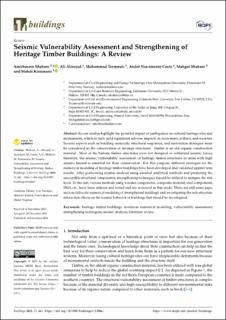| dc.contributor.author | Shabani, Amirhosein | |
| dc.contributor.author | Alinejad, Ali | |
| dc.contributor.author | Teymouri, Mohammad | |
| dc.contributor.author | Nascimento Costa, André | |
| dc.contributor.author | Shabani, Mahgol | |
| dc.contributor.author | Kioumarsi, Mahdi | |
| dc.date.accessioned | 2022-03-18T12:45:10Z | |
| dc.date.available | 2022-03-18T12:45:10Z | |
| dc.date.created | 2022-01-07T23:11:44Z | |
| dc.date.issued | 2021-12-18 | |
| dc.identifier.issn | 2075-5309 | |
| dc.identifier.uri | https://hdl.handle.net/11250/2986211 | |
| dc.description.abstract | Recent studies highlight the potential impact of earthquakes on cultural heritage sites and monuments, which in turn yield significant adverse impacts on economies, politics, and societies. Several aspects such as building materials, structural responses, and restoration strategies must be considered in the conservation of heritage structures. Timber is an old organic construction material. Most of the historic timber structures were not designed to withstand seismic forces; therefore, the seismic vulnerability assessment of heritage timber structures in areas with high seismic hazard is essential for their conservation. For this purpose, different strategies for the numerical modeling of heritage timber buildings have been developed and validated against tests results. After performing seismic analysis using detailed analytical methods and predicting the susceptible structural components, strengthening techniques should be utilized to mitigate the risk level. To this aim, various methods using wooden components, composite material, steel components, SMA etc., have been utilized and tested and are reviewed in this study. There are still some gaps, such as full-scale numerical modeling of strengthened buildings and investigating the soil–structure interaction effects on the seismic behavior of buildings that should be investigated. | en_US |
| dc.description.sponsorship | This work is a part of the HYPERION project. HYPERION has received funding from the European Union’s Framework Programme for Research and Innovation (Horizon 2020) under grant agreement No 821054. | en_US |
| dc.language.iso | eng | en_US |
| dc.publisher | MDPI | en_US |
| dc.relation.ispartofseries | Buildings;Volume 11 / Issue 12 | |
| dc.rights | Navngivelse 4.0 Internasjonal | * |
| dc.rights.uri | http://creativecommons.org/licenses/by/4.0/deed.no | * |
| dc.subject | Heritage timber buildings | en_US |
| dc.subject | Nonlinear numerical modeling | en_US |
| dc.subject | Vulnerability assessments | en_US |
| dc.subject | Strengthening techniques | en_US |
| dc.subject | Seismic analyses | en_US |
| dc.subject | Literature reviews | en_US |
| dc.title | Seismic Vulnerability Assessment and Strengthening of Heritage Timber Buildings: A Review | en_US |
| dc.type | Peer reviewed | en_US |
| dc.type | Journal article | en_US |
| dc.description.version | publishedVersion | en_US |
| dc.rights.holder | © 2021 by the authors | en_US |
| dc.source.articlenumber | 661 | en_US |
| cristin.ispublished | true | |
| cristin.fulltext | original | |
| cristin.qualitycode | 1 | |
| dc.identifier.doi | https://doi.org/10.3390/buildings11120661 | |
| dc.identifier.cristin | 1976879 | |
| dc.source.journal | Buildings | en_US |
| dc.source.volume | 11 | en_US |
| dc.source.issue | 12 | en_US |
| dc.source.pagenumber | 1-25 | en_US |
| dc.relation.project | EU – Horisont Europa (EC/HEU): 821054 | en_US |

